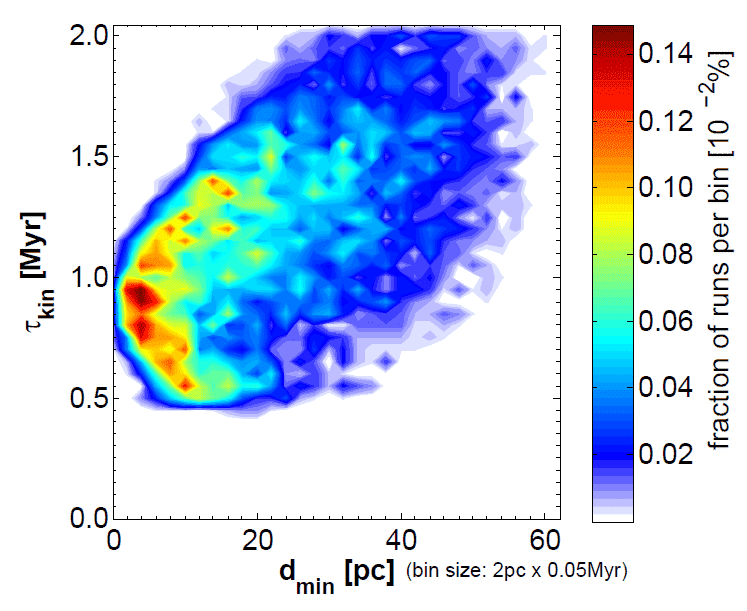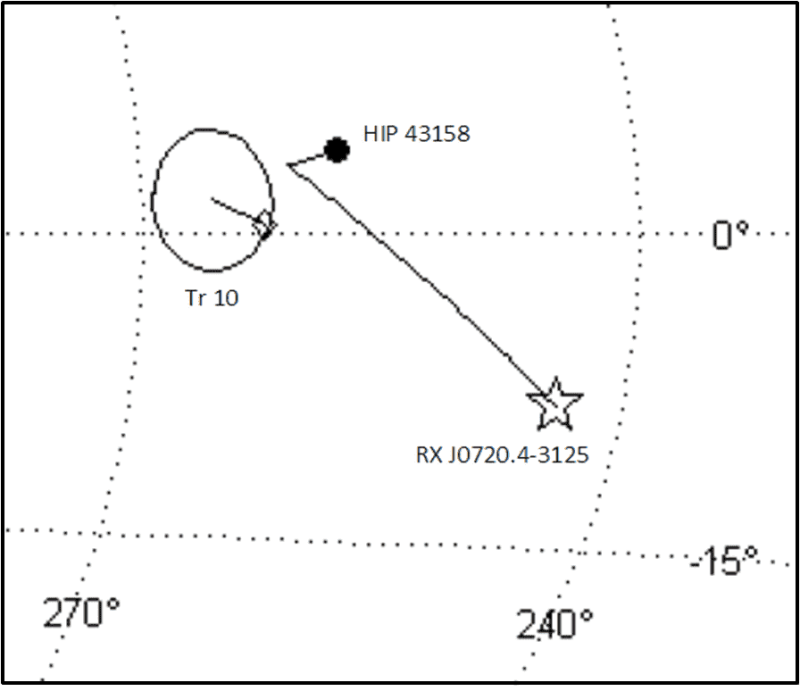Kinematics of young nearby neutron stars
There are ~100 young, nearby neutron stars (NSs) with distance and proper motion measurements known, most of them radio pulsars, plus a few radio-quiet thermal X-ray emitters. By tracing back the 3D motion of all those NSs, nearby young stellar associations, clusters and bubbles, and also all known young runaway stars, we can find close encounters in space and time, i.e. events, where NSs intersected with an association and/or a runaway star. Then, the NS may have been born in that association at that time in a supernova. An additional encounter with a runaway star would provide additional evidence.
Then, we know the kinematic age of that NS. We can compare the kinematic age with its characteristic spin-down age, which, in most cases, only gives the order of magnitude of the true (and kinematic) age. With kinematic ages we can probe cooling models for young NSs.
The difference between the association age (also age of the runaway star) and the kinematic age of the NS can be used to deduce the mass of the progenitor star. If we can find several NSs having possibly exploded within a few million years within the Local Bubble, we may be able to explain its origin by supernovae. For a recent (within a few million years) nearby supernova (within 100 to 150 pc), supernova debris like 60Fe should have been deposited in the Earth's crust. Such material has been detected. If we can find the NS formed by that supernova, we can constrain its distance and age, and maybe the mass (and, hence, debris yield) of the progenitor star, an important constraint for supernova and nucleosynthesis models.
By tracing back the travel paths of young neutron stars with known distances and proper motion, using a Monte-Carlo simulation (that takes all errors and the unknown radial velocity into account), we can identify the most probable kinematic age and distance of the supernova from the parent association/ cluster (figure below, RX J0720.4-3125 as an example). Using the kinematic ages and the temperatures from X-ray spectroscopy, we can compare both quantities with cooling curves (that depend on mass, composition/ EoS and cooling process).
Probability of the close encounter of RX J0720.4-3125 with its former companion candidate HIP 43158 (Tetzlaff et al. 2011, MNRAS 417, 617) near the Trumpler 10 association ~0.9 Myr ago.
Grafik: N. TetzlaffFlight paths of RX J0720.4-3125, HIP 43158 and Trumpler 10 projected onto a galactic coordinate system (Tetzlaff et al. 2011, MNRAS 417, 617).
Grafik: N. TetzlaffOur publications on this research:
Neuhäuser, R., Gießler, F. and Hambaryan, V.V. (2020): A nearby recent supernova that ejected the runaway star ζ Oph, the pulsar PSR B1706−16, and 60Fe found on Earth. Mon. Not. R. Astron. Soc. 498, 899–917. Online: https://ui.adsabs.harvard.edu/abs/2020MNRAS.498..899N/abstractExterner Link
Dinçel, B., Neuhäuser, R., Yerli, S.K., Ankay, A., Tetzlaff, N., Torres, G. and Mugrauer, M. (2015): Discovery of an OB runaway star inside SNR S147. Mon. Not. R. Astron. Soc. 448, 3196–3205. Online: http://adsabs.harvard.edu/abs/2015MNRAS.448.3196DExterner Link
Tetzlaff, N., Torres, G., Bieryla, A. and Neuhäuser, R. (2014): New radial velocities for 30 candidate runaway stars and a possible binary supernova origin for HIP 9470 and PSR J0152-1637. Astron. Nachr. 335, 981–991. Online: http://adsabs.harvard.edu/abs/2014AN....335..981TExterner Link
Tetzlaff, N., Dinçel, B., Neuhäuser, R. and Kovtyukh, V.V. (2014): The origin of the young pulsar PSR J0826+2637 and its possible former companion HIP 13962. Mon. Not. R. Astron. Soc. 438, 3587–3593. Online: http://adsabs.harvard.edu/abs/2014MNRAS.438.3587TExterner Link
Tetzlaff, N., Torres, G., Neuhäuser, R. and Hohle, M.M. (2013): The neutron star born in the Antlia supernova remnant. Mon. Not. R. Astron. Soc. 435, 879–884. Online: http://adsabs.harvard.edu/abs/2013MNRAS.435..879TExterner Link
Trepl, L., Hambaryan, V.V., Pribulla, T., Tetzlaff, N., Chini, R., Neuhäuser, R., Popov, S.B., Stahl, O., Walter, F.M. and Hohle, M.M. (2012): Is there a compact companion orbiting the late O-type binary star HD 164816?. Mon. Not. R. Astron. Soc. 427, 1014–1023. Online: http://adsabs.harvard.edu/abs/2012PASA...29...98TExterner Link
Tetzlaff, N., Schmidt, J.G., Hohle, M.M. and Neuhäuser, R. (2012): Neutron Stars From Young Nearby Associations: The Origin of RX J1605.3+3249. Publ. Astron. Soc. Aust. 29, 98–108. Online: http://adsabs.harvard.edu/abs/2012PASA...29...98TExterner Link
Hui, C.Y., Huang, R.H.H., Trepl, L., Tetzlaff, N., Takata, J., Wu, E.M.H. and Cheng, K.S. (2012): XMM-Newton Observation of PSR B2224+65 and Its Jet. Astrophys. J. 747, 74. Online: http://adsabs.harvard.edu/abs/2012ApJ...747...74HExterner Link
Tetzlaff, N., Eisenbeiss, T., Neuhäuser, R. and Hohle, M.M. (2011): The origin of RX J1856.5−3754 and RX J0720.4-3125 – updated using new parallax measurements. Mon. Not. R. Astron. Soc. 417 (1), 617–626. Online: http://adsabs.harvard.edu/abs/2011MNRAS.417..617TExterner Link
Tetzlaff, N., Neuhäuser, R. and Hohle, M.M. (2011): A catalogue of young runaway Hipparcos stars within 3 kpc from the Sun. Mon. Not. R. Astron. Soc. 410 (1), 190–200. Online: http://adsabs.harvard.edu/abs/2011MNRAS.410..190TExterner Link
Boldin, P.A., Popov, S.B. and Tetzlaff, N. (2011): A web-tool for population synthesis of near-by cooling neutron stars: An on-line test for cooling curves. Astron. Nachr. 332 (2), 122–127. Online: http://adsabs.harvard.edu/abs/2011AN....332..122BExterner Link
Tetzlaff, N., Neuhäuser, R., Hohle, M.M. and Maciejewski, G. (2010): Identifying birth places of young isolated neutron stars. Mon. Not. R. Astron. Soc. 402, 2369–2387. Online: http://adsabs.harvard.edu/abs/2010ApJ...708.1728MExterner Link
Tetzlaff, N., Neuhäuser, R. and Hohle, M.M. (2009): The origin of the Guitar pulsar. Mon. Not. R. Astron. Soc. Lett. 400, L99. Online: http://adsabs.harvard.edu/abs/2009MNRAS.400L..99TExterner Link
Hohle, M., Eisenbeiss, T., Mugrauer, M., Freistetter, F., Moualla, M., Neuhäuser, R., Raetz, S., Schmidt, T., Tetzlaff, N. and Vaňko, M. (2009): Photometric study of the OB star clusters NGC 1502 and NGC 2169 and mass estimation of their members at the University Observatory Jena. Astron. Nachr. 330, 511–517. Online: http://adsabs.harvard.edu/abs/2009AN....330..511HExterner Link
Hohle, M.M., Neuhäuser, R. and Tetzlaff, N. (2008): Using radioactivities to improve the search for nearby radio-quiet neutron stars. New Astron. Rev. 52, 405–408. Online: http://adsabs.harvard.edu/abs/2008NewAR..52..405HExterner Link

